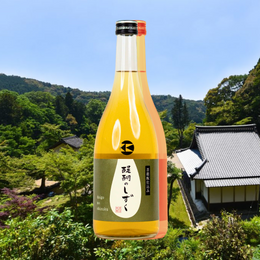
Sake is going through a quiet revolution - on the surface, Sakes are more globally recognised than ever, a rare feat for a drink of Asian descent. Yet amidst that big win lies a line of distinction that is undoubtedly bound to be more prominent in the years to come - that is the divergence between traditional Sake and craft Sake.
Borne of an inability of aspiring new brewers to start their own Sake brewery - Japan had stopped issuing new Sake brewing licenses quite some time ago - this small yet growing breed of brewers simply won't be deterred, and have found their paradise in the Japanese drinks classification of "other brewed alcohol". The catch-all term has really become a playground for these craft Sake brewers who have found that by having to make Sake in deliberate defiance of traditional rules, they can in effeect play this to their advantage and thus produce declassified craft Sakes (because they cannot legally produce Sake without a Sake brewing license, they have taken to altering the Sake recipes and thus cannot call their brews "Sake") that embody flavours impossible of traditional Sakes! Think raspberry flavours or hop-fortified Sakes - it's a phenomenon unheard of just a decade ago!


One ingredient, many interpretations.
And that's precisely what makes the world of Sakes so exciting - on the one hand traditional Sake makers continue to pursue the likes of new rice varietals and ever more intense rice polishing ratios, craft Sake producers on the other hand find ways to imbue their Sakes with new flavours impossible to achieve with just rice alone, thereby drawing a younger crowd of new generation Sake drinkers.
At the heart of the craft Sake revolution is one haccoba.
Established in just 2021 by Taisuke Sato, a young former IT worker who had dreamt of producing Sake that would help to revitalise the Fukushima Prefecture, haccoba brewery has already gone on to make waves by helping to lead the craft Sake movement by means of reimagining what Sake could be.

Taisuke Sato wants to revitalise Fukushima.
Sato had believed that if the once nuclear accident site (that is now cleared and marked safe to return to) had begun to show vibrant signs of life again, this would in turn multiply in waves of new and exciting possibilities to rebuild the city. He thus set about establishing haccoba brewery in the city hoping that it would attract Sake drinkers to come visit the city - it clearly worked out fantastically!
haccoba had found early success with its dry-hopped Sake, which whilst sounding rather out of this world, is actually rooted in tradition. Much like beers which were once brewed with hop flowers that helped to fortify the beer for its travels, when back in the day it was stored in barrels and carried by ship, Sake too was hopped for the same purposes. This obviously disappeared with the invention of refrigeration and faster freight times that allow for Sakes to be delivered fresh and intact. Yet Sato would find the historical practice curious and had thus set about recreating a hopped Sake - this was a big hit and had immediately put haccoba on the map.

Brett is used for some of the world's most iconic beers from Belgium.
Now, in the spirit of continuous and boundless experimentation, haccoba has been working on something quite special that I've really been looking forward to trying! That's their hanamoto bretta - if you're a beer lover, the name should be quite the giveaway. This expression sees the use of brett, or brettanomyces, a particular wild yeast that is best known for producing funky and often rustic and barnyard aromas and flavours - it's most commonly featured in traditional Belgian ales, and are the not so secret magic ingredient of some of the world's most iconic Belgian ales! And this is all on top of the hops that's been fermented with the Sake - and hence the hanamoto name, which can be translated as hops in Japanese.
And so haccoba tells of how they've long been planning to establish a brewery in Belgium, and thus have harboured the hopes of one day combining elements of Japanese Sake with Belgian beers. As such they had wanted to infuse their Sake with Brett. In this endeavour haccoba had decided to consult with fellow local Japanese craft brewer, Far Yeast Brewing, who had for awhile now experimented with Brett in their craft beers. The result of this collaboration was haccoba thus using Far Yeast's oak barrels that had previously held Brett fermented beers, allowing for a secondary fermentation with Brett in their Sake. Haccoba's hanamoto bretta is therefore said to embody an almost Belgian lambic style.

Local Yamatsuri raspberries.
In the second iteration of haccoba's hanamoto bretta, the brewery had decided to raise the bar once more by adding local raspberries from Yamatsuri in the Fukushima Prefecture - and thus framboise!
"It was difficult to brew, where I felt the immaturity of a brewer who still can't make it as intended, but also the depth of fermentation that made me think, "This is why I can't quit."" says Sato.
With a whole lot going on here, this may still be an early effort from haccoba, and yet it's for that reason it's been exceptionally exciting as both a Sake and beer lover to follow along the brewery's progress and see them grow with each expression and year!
Let's give this a go!
PS. A big, big shoutout to Alex from Omu Nomu Craft Sake Bar - bar none the number one spot in Singapore to try a constantly rotating lineup of craft Sakes by the glass, and with a team that's extremely passionate and just the loveliest people! And also big thanks goes to Sake Matsuri, which is THE Sake festival to be at in Singapore where all the best Sake folks in town are gathered in one spot, and with hundreds of Sakes to explore and try from - if you're into Sake's or are dipping your toes in, this is the best place to try so many of them and find your favorite!
Sake Review: haccoba Hanamoto Bretta (Framboise)

Tasting Notes
Colour: Blush of Pink
Aroma: Deep fragrant tropical white fruit aromas of lychees, mangosteens, langsat and longans. It's lightly musky, yet at the same time vibrantly florals with aromas of raspberries that seem to combine with these incredibly supple and creamy tones of custard, to give something of a custard pudding topped with raspberry sauce. This extends to rose florals too, with aromas of ispahan. At the same time there's also this zesty tanginess of lemon curd and passionfruit. It's a trifecta super aromatic combo of tropical white fruit, rosy red fruit and floral tones, as well as a zestiness of tropical citrus, all combined with this supple richness of custard pudding.
Taste: Medium-bodied here, still carrying with it that light tanginess of a sort of tropical fruit cordial consisting of starfruits and mangosteens. Here the red fruits take the fore, with gentle yet broad and deep tones of raspberries and strawberries. It's just gently sweet, rendered over a velvety and rounded texture that's rich and lightly syrupy. Not much funkiness to be had over here. It's very much firm and supple, almost like the cross of a mochi with a gently fizzy isotonic drink that's just gently infused with red fruits and tropical fruits.
Finish: As it recedes it turns more dry here, with the rustic, barnyard funkiness beginning to surface more prominently. Funky tropical white fruit of rambutans, longans and lychees begin to show up, rather musky, working towards a clean and soft, yet firm finish, with the tropical fruits persisting in aromatics.

My Thoughts
Oh wow! This was absolutely stunning! It was such a wild ride from start to finish!
Already on the nose, I was completely taken away by the complexity and vibrance of these vivid and expressive aromas. It was a perfectly composed bouquet of white tropical fruit, just lightly musky, red berries and florals a la potpourri, and then also a zestiness of tropical citrus - this all paired with the utmost supple and rich, alittle bit confectionary, custard pudding. I was floored!
On to the palate, this has the gentle sweetness of rice mochi, and the same richness really, yet conveyed over a softly fizzy (and firm) body that was almost of an isotonic drink of sorts. The texture was just beautiful! This was then infused with a light tanginess of tropical fruits, along with that almost rosy red tones of red berries - it's giving raspberry and mangosteen daifuku. Yet into the finish, there were more surprises in store - it began to recede to give a well-balanced contrasting dryness, that also surfaced some of that brett influence of rustic and barnyard funk, albeit still really gentle. This mostly carried through to show up in the form of funky tropical white fruits of rambutans, longans and lychees, which lingered all the way through an entirely firm and seamless finish.
Absolutely perfect! This was such an incredibly fun and tasty craft Sake! Off the bat it's just so delightful with all these lovely flavours - although I must say the brett isn't particularly noticeable here - and then there's just all these little twists and turns to be discovered. It's compelling and engaging, and downright approachable!
Kanpai!

@111hotpot







